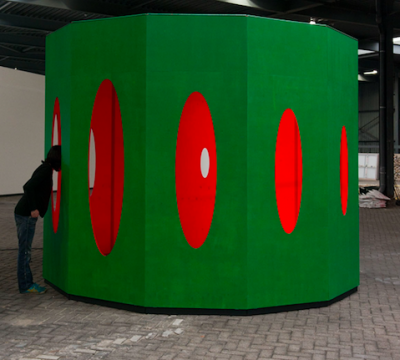karin van pinxteren
The work of Karin van Pinxteren (Den Bosch, 1967) negotiates between the desire for contact with the other and with the surrounding space. In two- and three-dimensional work, spatial installations and performance, she shapes this concept through the boundless ‘no man’s land’ that lies between sending and receiving. Alongside the image, language plays an important role in this.
Her work is a sequence of notes on the known and the unknown, on attempted communication and questions about art.
Karin van Pinxteren studied at the University of the Arts in Breda. Previous exhibits include Amsterdam, Brussels, Prague and New York.
Miracle chamber with flickering light
Wheel of life, zoetrope, ‘wondertrommel’ — these fairylike words spring to mind upon viewing the work of artist Karin van Pinxteren. The inventor of the zoetrope was Joseph Plateau — but not so much his invention was enchanting, as the effect of it. In 1833 Plateau, a Belgian physicist and mathematician, after years of experimentation with light fragmentation and research into the phenomenon of ‘afterimages’, designed a cylinder with a painted interior and holes in the side. If you spun the cylinder whilst peering through the slits, a small miracle occurred: horses began to move, ballerinas turned pirouettes. None of those who got their hands on such a drum, could or can resist the temptation of those moving images in Plateau’s zoetrope.
The same goes for La Chambre de Cathérine, a gigantic, seductive ‘wondertrommel’, set up at the Noletloodsen by Van Pinxteren (1967). Twelve bright green painted panels form a dodecagonal room. Each panel has an elliptic opening through which one can, and instantly wants to, peep inside. There, an image is projected onto the fire engine red walls. A woman with a valise enters and leaves a room. But where is she going — to yet another room? What does she see? And what do you?
You can only look, you can’t step into the zoetrope. That Van Pinxteren — initially trained in architectural and graphic design but successfully active for years as an autonomous performance and installation artist — is clear about. Just as her previous installation Kurt’s Zimmer (2006), which had a similar structure to La Chambre de Cathérine, this new work forms a physically bordered universe. The ellipses serve as spy holes, but their shape is also suggestive of portrait frames reflecting an image themselves. This gives rise to the suggestion of threedimensionality of forms that are in fact flat.
The work of Van Pinxteren always bears such ambiguity. Drawings, objects of wood and cardboard (with words that detach themselves from the primary form like rays of light), photos, videos, socles and spatial installations like La Chambre de Cathérine are about making contact, but just as much about avoiding contact, about seeing and seeing through, secrecy, distance and proximity — as much in form as in subject.
That subject is often very literary — a trip the Pyrenees undertaken by the later prosecuted German writer Kurt Tucholsky in 1927, a youth memory, a personal experience. ‘I’m not so extraverted,’ says the artist herself. ‘There’s much I daren’t do. I wouldn’t dare ask someone a bold question, for example; or another thing: I’ve always been afraid of opening doors.’
That tension between abstraction and figuration, between form and fable, is beautifully evoked by Van Pinxteren in her latest installation at the Noletloodsen. In La Chambre de Cathérine, she sublimates early memories of a camping holiday with her parents and that which is hidden from the outside world in a short story and in this abstract miracle chamber. There was once a father, who liked to look with his hands, an abandoned house with a wooden leg hidden under the stairs, a stolen cassette of French chansonnier Michel Sardou. Now there is a woman with a valise. A name, Cathérine Sardou, and a story about a man, Ambroise Sardou. In Van Pinxteren’s miracle chamber, all of those elements combine. But not explicitly or demonstratively.
La Chambre de Cathérine introduces in abstracto what it’s like when life is full of secrets. We can sense those secrets, we can ponder them, we can sometimes taste, nearly touch them. A woman enters a room, through a corridor. A light flashes on and off. The lamp sharpens our senses. If only we could be there, inside, amidst that thrilling red. There, we could find out everything, surely. ‘There’ is so very different from here, with an ellipse as the sole gateway.


